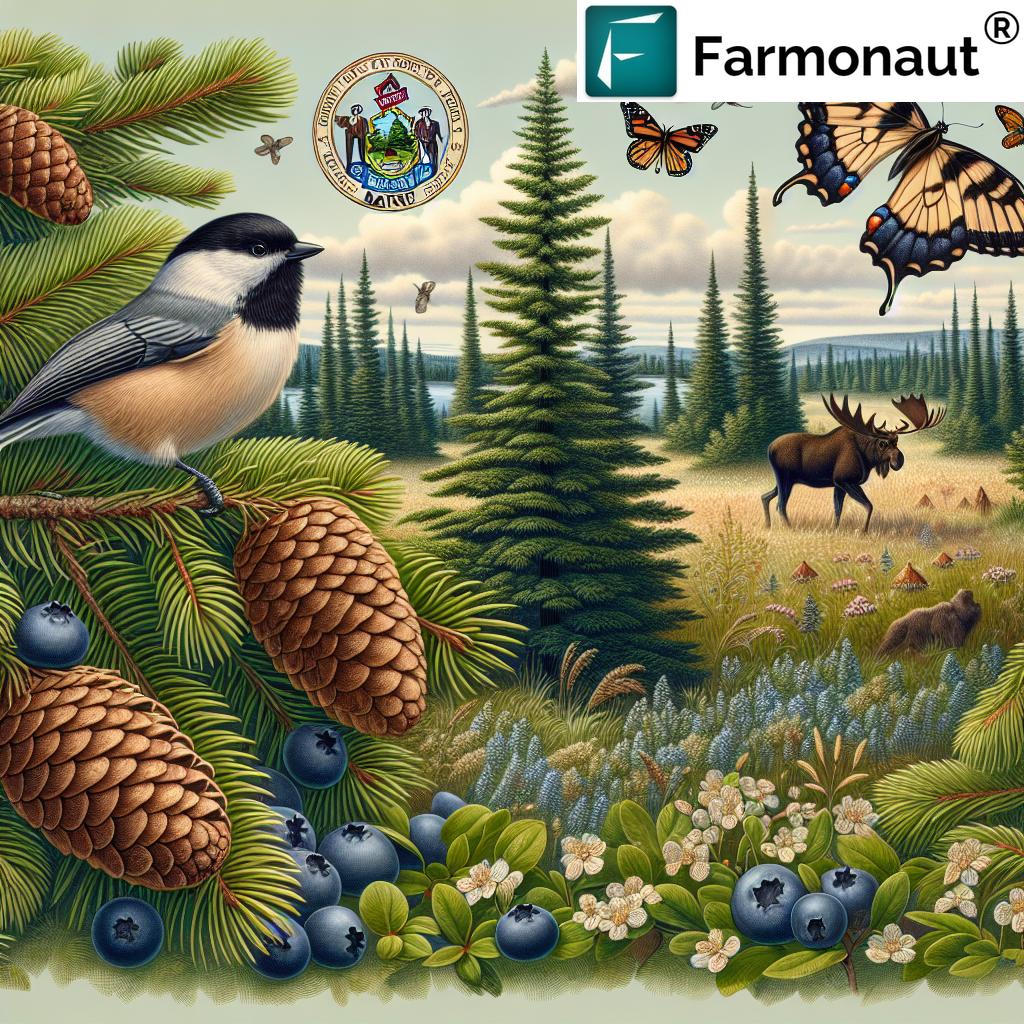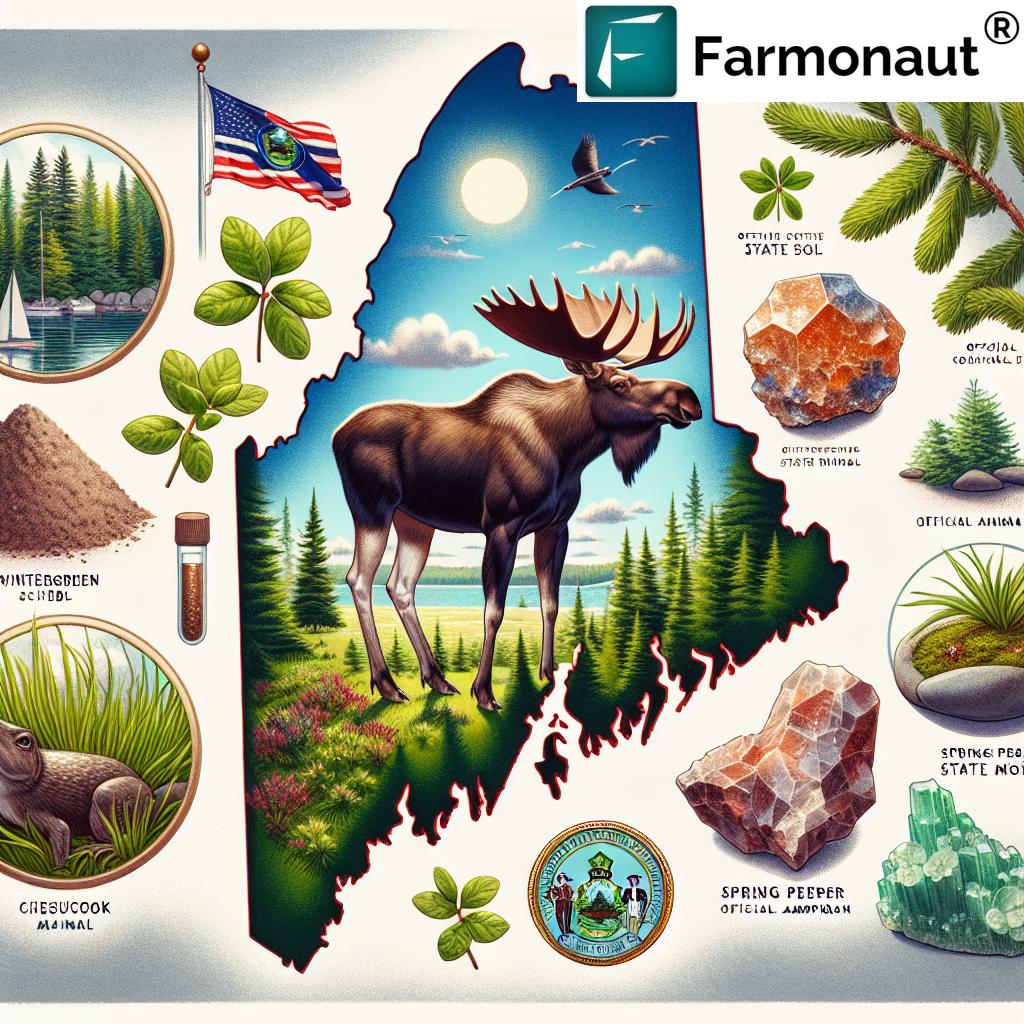Maine’s State Symbols: Exploring the Rich Tapestry of Cultural Identity and Legislative Trends
“Maine has adopted 31 official state symbols since the 1960s, reflecting its rich cultural identity and natural heritage.”
Welcome to our comprehensive exploration of Maine’s state symbols, where we delve into the heart of the Pine Tree State’s cultural identity and legislative landscape. As we embark on this journey, we’ll uncover the fascinating history behind Maine’s official emblems and examine the ongoing efforts to expand this rich tapestry of representation.
The Evolution of Maine’s State Symbols
Maine’s collection of state symbols has grown significantly since the 1960s, showcasing the state’s commitment to celebrating its unique heritage and natural wonders. From longstanding icons like the state tree and bird to more recent additions such as the state butterfly and song, each symbol tells a story about Maine’s character and values.

Let’s take a closer look at some of Maine’s most iconic symbols:
- State Tree: Eastern White Pine (Pinus strobus)
- State Bird: Black-capped Chickadee (Poecile atricapillus)
- State Flower: White Pine Cone and Tassel
- State Animal: Moose (Alces alces)
- State Insect: Honeybee (Apis mellifera)
These symbols have stood the test of time, serving as enduring representations of Maine’s natural beauty and ecological diversity. However, the list continues to grow as new proposals emerge, reflecting the state’s evolving identity and the passions of its citizens.
Recent Proposals: Expanding Maine’s Symbolic Landscape
The landscape of Maine’s state symbols is far from static. Recent legislative sessions have seen a flurry of proposals aimed at adding new official emblems to the state’s roster. Let’s explore some of the most notable recent additions and pending proposals:
The Spring Peeper and Wood Turtle: Amphibian and Reptile Representatives
State Rep. Laurie Osher of Orono has introduced bills to designate the spring peeper as Maine’s official amphibian and the wood turtle as the official reptile. These proposals highlight the state’s rich biodiversity and the importance of protecting its varied ecosystems.
The spring peeper, with its distinctive call heralding the arrival of spring, embodies the resilience of Maine’s wildlife. Meanwhile, the wood turtle, known for its intelligence and longevity, represents the state’s commitment to conservation efforts.
The Seppala Siberian Sled Dog: A Symbol of Courage and Resilience
Another intriguing proposal seeks to name the Seppala Siberian sled dog as Maine’s official state dog. This breed’s history is intertwined with the famous 1925 serum run to Nome, Alaska, where sled dogs, including the renowned Togo, played a crucial role in delivering life-saving medicine.
The Seppala Siberian’s proposed designation speaks to Maine’s appreciation for qualities like courage, endurance, and loyalty – traits that resonate deeply with the state’s identity.
The Legislative Process: From Proposal to Official Symbol
The journey from proposal to official state symbol is a fascinating process that involves multiple stakeholders and often sparks lively debates. Here’s a simplified overview of how a new symbol becomes official in Maine:
- Proposal Submission: A bill is introduced by a legislator, often at the request of constituents or interest groups.
- Committee Review: The proposal is assigned to a relevant committee for review and public hearings.
- Legislative Debate: If approved by the committee, the bill moves to the full legislature for debate and voting.
- Governor’s Approval: If passed by both houses, the bill goes to the governor for final approval or veto.
- Enactment: Upon the governor’s signature, the new symbol becomes officially recognized by the state.
This process ensures that each new symbol is thoroughly vetted and represents a meaningful addition to Maine’s cultural identity.
The Role of Citizen Involvement in Shaping Maine’s Symbols
“Young students have played a significant role in proposing new state emblems, contributing to Maine’s evolving symbolic landscape.”
One of the most heartening aspects of Maine’s state symbol legislation is the active involvement of its citizens, particularly young students. This engagement not only fosters a sense of civic pride but also provides valuable educational opportunities.
A prime example of this involvement was the successful campaign by fifth-graders at Loranger Memorial School to designate the Pink-edged Sulphur as Maine’s state butterfly. This initiative not only resulted in a new official symbol but also demonstrated the power of youth engagement in the legislative process.

The Significance of State Symbols in Modern Maine
While some may question the relevance of state symbols in today’s fast-paced world, these emblems serve several important functions:
- Cultural Identity: Symbols help define and celebrate Maine’s unique character and heritage.
- Educational Tools: They provide valuable learning opportunities for students studying state history and civics.
- Conservation Awareness: Many symbols, particularly those representing flora and fauna, raise awareness about environmental conservation.
- Economic Impact: Some symbols, like the state berry (wild blueberry), have significant economic implications for local industries.
As we continue to explore Maine’s symbolic landscape, it’s clear that these official designations play a vital role in shaping the state’s identity and fostering a sense of community pride.
Comparison: Evolution of Maine’s State Symbols
| Symbol Category | Current Official Symbol | Year Adopted | Proposed/Pending Symbols |
|---|---|---|---|
| State Tree | Eastern White Pine | 1945 | N/A |
| State Bird | Black-capped Chickadee | 1927 | N/A |
| State Flower | White Pine Cone and Tassel | 1895 | N/A |
| State Insect | Honeybee | 1975 | N/A |
| State Butterfly | Pink-edged Sulphur | 2022 | N/A |
| State Amphibian | N/A | N/A | Spring Peeper (Proposed 2024) |
| State Reptile | N/A | N/A | Wood Turtle (Proposed 2024) |
| State Dog | N/A | N/A | Seppala Siberian Sled Dog (Proposed 2024) |
This table provides a snapshot of Maine’s symbolic evolution, highlighting both established symbols and recent proposals. It’s a testament to the state’s ongoing commitment to recognizing and celebrating its diverse heritage.
The Impact of Technology on Agriculture and State Identity
While we explore Maine’s state symbols, it’s worth noting how technology is shaping the future of agriculture – a crucial aspect of the state’s identity. Companies like Farmonaut are at the forefront of this agricultural revolution, offering innovative solutions that could indirectly influence how states like Maine view their agricultural heritage.
Farmonaut provides advanced, satellite-based farm management solutions via Android, iOS, web/browser apps, and API. Their mission to make precision agriculture affordable and accessible aligns well with states looking to modernize their agricultural practices while preserving their traditional identity.
For more information on how technology is transforming agriculture, you can explore Farmonaut’s offerings:
The Debate: Significance vs. Frivolity
The ongoing proposals for new state symbols have sparked a debate about the significance of these designations. Critics argue that such legislative efforts might be seen as frivolous or distracting from more pressing issues. However, proponents, including Rep. Osher, contend that these discussions serve a valuable purpose:
- They engage citizens, especially young people, in the legislative process.
- They draw attention to the wide range of issues addressed by state government.
- They provide opportunities to educate the public about local wildlife and ecosystems.
This debate reflects a broader conversation about the role of cultural symbols in modern governance and civic engagement.
Maine’s Symbols in a National Context
Maine’s collection of 31 state symbols places it in the middle range compared to other states. While some states have fewer official emblems, others, like Texas, boast over 70 symbols. This diversity reflects the unique approach each state takes in representing its identity.
The trend of adopting state symbols gained momentum after the 1893 Chicago World’s Fair, which popularized the concept of state flowers and other emblems. Since then, states have continually added to their symbolic repertoires, often reflecting changing cultural values and environmental awareness.
The Future of Maine’s State Symbols
As Maine continues to evolve, so too will its collection of state symbols. The ongoing proposals for new emblems suggest a vibrant future for this aspect of state identity. Some potential trends we might see include:
- Increased focus on environmental symbols to highlight conservation efforts
- More technology-related symbols reflecting Maine’s growing tech sector
- Symbols that celebrate the state’s diverse communities and cultures
Whatever the future holds, it’s clear that Maine’s state symbols will continue to play a crucial role in shaping and reflecting the state’s identity.
Conclusion: Celebrating Maine’s Rich Symbolic Tapestry
Maine’s state symbols offer a fascinating glimpse into the heart and soul of the Pine Tree State. From the majestic Eastern White Pine to the humble spring peeper, each emblem tells a story of Maine’s natural beauty, cultural heritage, and evolving identity.
As we’ve explored in this comprehensive overview, the process of adopting new symbols is more than just a legislative exercise – it’s a reflection of civic engagement, educational opportunity, and cultural pride. Whether you’re a lifelong Mainer or a curious visitor, these symbols provide a unique lens through which to view and appreciate the diverse tapestry that is Maine.
As the state continues to grow and change, its symbols will undoubtedly evolve as well, always striving to capture the essence of what makes Maine truly special. We encourage you to explore these symbols further, visit the places they represent, and perhaps even get involved in proposing new emblems that resonate with your vision of Maine.
FAQs about Maine’s State Symbols
- Q: How many official state symbols does Maine currently have?
A: Maine has adopted 31 official state symbols since the 1960s. - Q: What is Maine’s state tree?
A: Maine’s state tree is the Eastern White Pine (Pinus strobus). - Q: When was the first state symbol adopted in Maine?
A: The first state symbol, the state flower (White Pine Cone and Tassel), was adopted in 1895. - Q: What is the most recently adopted state symbol in Maine?
A: The most recent addition is the Pink-edged Sulphur butterfly, adopted as the state butterfly in 2022. - Q: How can citizens propose a new state symbol?
A: Citizens can work with their local state representatives to introduce a bill proposing a new state symbol. - Q: Are there any proposed state symbols currently under consideration?
A: Yes, recent proposals include the spring peeper as the state amphibian, the wood turtle as the state reptile, and the Seppala Siberian sled dog as the state dog. - Q: What is Maine’s state song?
A: Maine’s state song is “State of Maine Song,” adopted in 1937. - Q: Does Maine have an official state food?
A: While Maine doesn’t have an official state food, it does have a state berry (wild blueberry) and a state treat (whoopie pie). - Q: How does Maine compare to other states in terms of the number of official symbols?
A: With 31 symbols, Maine falls in the middle range compared to other states. Some states have fewer, while others, like Texas, have over 70 symbols. - Q: Can state symbols change over time?
A: Yes, state symbols can be changed through legislative action, although this is relatively rare. More commonly, new symbols are added to the existing list.
Earn With Farmonaut: Affiliate Program
Earn 20% recurring commission with Farmonaut’s affiliate program by sharing your promo code and helping farmers save 10%. Onboard 10 Elite farmers monthly to earn a minimum of $148,000 annually—start now and grow your income!
We hope this comprehensive exploration of Maine’s state symbols has deepened your appreciation for the Pine Tree State’s rich cultural heritage and ongoing legislative trends. As we continue to witness the evolution of these emblems, we’re reminded of the dynamic nature of state identity and the important role that citizens play in shaping it.
For those interested in further exploring the intersection of technology and agriculture, we encourage you to visit Farmonaut’s API and API Developer Docs. These resources offer insights into how modern agricultural practices are being enhanced through innovative technologies.
As we conclude, let’s remember that each state symbol, whether long-established or newly proposed, serves as a thread in the rich tapestry of Maine’s identity. They are not mere legislative curiosities but powerful representations of the state’s values, natural wonders, and cultural heritage. By understanding and celebrating these symbols, we gain a deeper appreciation for the unique character of Maine and its people.


















